Over 50 percent of users demand a fast response from the organization at any time of day or week. To match the needs of such a demanding consumer, brand owners invest heavily in 24/7 customer support.
In most cases, consumers have the same queries, which an appropriately constructed software can answer. Install chatbots in your business, and one of the problems will be solved.
Furthermore, users don't mind: at least 40% are willing to communicate with chatbots. And if the program is properly designed, the chances of receiving a positive reaction grow to 90%. Building a chatbot may require investment, but it will ultimately be worthwhile. Otherwise, you risk losing a client, who will most likely leave your website for a competitor. Even the most qualified manager cannot always reply to a user's request promptly. Unfortunately, the human aspect persists. So, chatbots would be an excellent safety net.
Let's go over chatbots in greater detail.
What Does the Chatbot Concept Imply?
We bet you've dealt with chatbots more than once. They greet us whenever we visit a particular website. "Welcome to our site. "How can I help you?" - they ask us, and we receive an immediate response.
But what is this, a chatbot? Why is it needed, and what can it do? What are the advantages of employing chatbots? Let's go through all of this in order.
A chatbot is a virtual interlocutor that functions as an assistant. It streamlines the process of interacting with computers via speech or text. In essence, a chatbot replicates the behavior of a real-life human.
The chatbot may ask and answer questions and find helpful information based on the user's request.
How everything started
Building a chatbot is not novel and has yet to emerge in the twenty-first century. The first attempts to converse compassionately with a computer robot occurred in the mid-twentieth century, perhaps in the 1950s. Eliza's chatbot, which imitated a conversation with a psychotherapist, first emerged in 1966.
Chatbots first appeared in 2018 and have since grown in popularity. Oracle, the world's largest software provider, reports that more than 80% of organizations worldwide currently use or plan to use chatbots for client needs.
What are modern chatbots capable of?
Because modern algorithms are so intelligent, chatbots can advise users in even the most complex circumstances. However, if you ask the same question differently, the chatbot will still understand you and provide the correct answer. Questions like "Where is the nearest hotel?" and "What hotel is the closest to my location?" are equally apparent in the program. As a last option, the chatbot might direct the customer to a real person (an account manager).
Are you considering building a chatbot but need to know if it's worthwhile? We'll persuade you that it's a good idea by outlining the most recent trends in our topic of discussion.
Chatbot Stats
- The chatbot market is expected to grow at a stunning 23.3% yearly, reaching $15.5 billion by 2028.
- According to studies, the chatbot algorithm speeds up the process of finding the required product by 70%. This amounts to a 65+% increase in sales (assuming that more than 25% of sales began with chatbot interactions).
- Salesforce research indicates the effectiveness of utilizing chatbots to achieve business goals. According to the research, over 70% of consumers prefer to engage with websites and address urgent concerns via chatbots.
- Bots can perform 30% of live chats and 80% of routine tasks.
Chatbot classification
The most accessible classification approach of chatbots is by how they communicate with users:
- Text communication (the most popular option today);
- Combining text and voice (for instance, Siri and Google Assistant). In this option, the user's voice request turns into a text one;
- Voice chatbots (of great demand in the United States, for example, Amazon Echo).

Before implementing chatbots in your organization, it's essential to understand that these programs might be classified differently:
- The simplest chatbots. They work according to predefined commands based on a particular keyword list. They're easy to develop but limited in functionality;
- Self-educated chatbots. They work based on Machine Learning and NLU (Natural Language Understanding) algorithms. These chatbots are somewhat challenging to develop but much more effective in the long run.
Given the increased digitalization and development of the IT sector, self-educated chatbots have a bright future. However, we will discuss this in more detail in the following section of our article.
How a chatbot works for business
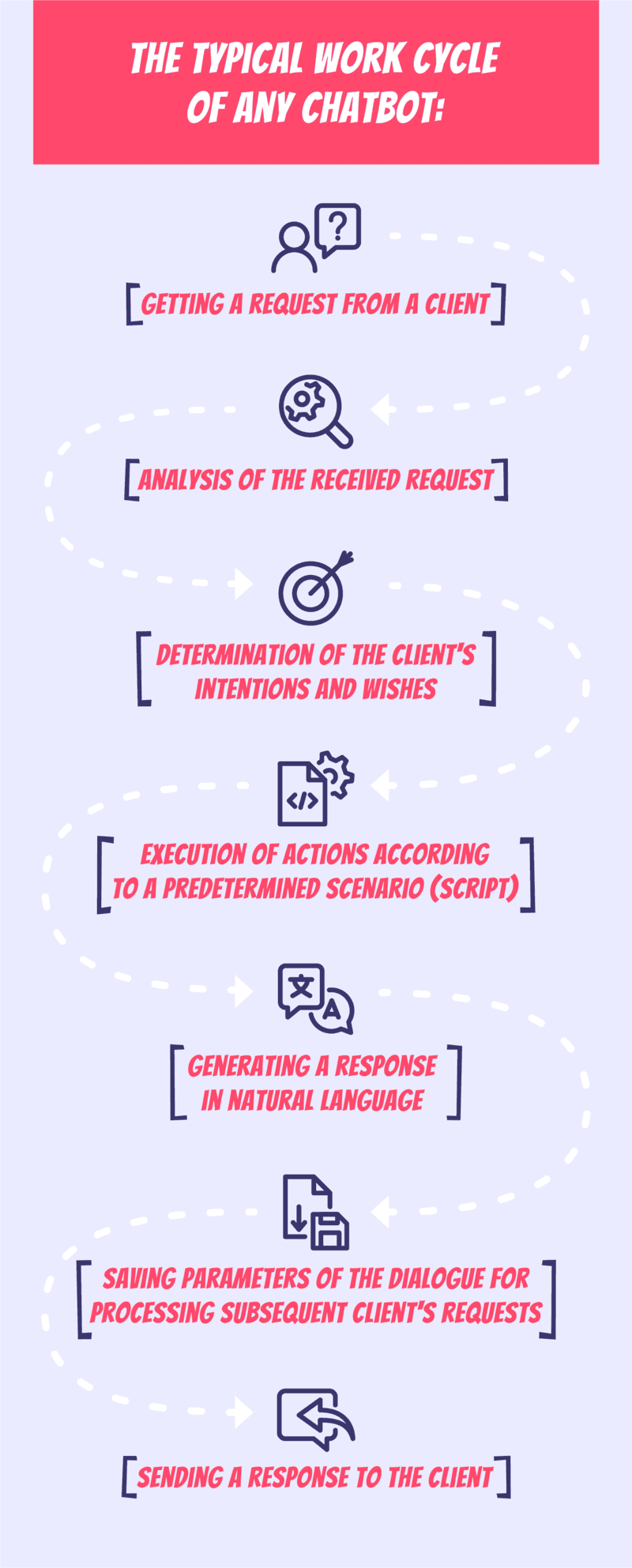
Until 2015, chatbots were built using a rule-based method (more specifically, they were the simplest chatbots discussed in the previous section). However, since 2015, the rise of Big Data and Machine Learning has resulted in new ways of communicating with the consumer. As a result, many chatbots employ advanced Data Science techniques such as NLU and NLP, efficient speech recognition, neural network-based word processing, and different AI tools.
The modern chatbot is trying to match your question with what it can now understand. And the longer a chatbot engages with you, the better it learns to assist you with the method you require. Let's find out how chatbots help organizations increase revenues.
Chatbot Advantages for Business
- Sale growth. Over fifty percent of customers quit an online store after viewing its catalog. The reasons may range from the user's misunderstanding of their needs to their incapacity to find what they seek. Chatbots overcome some of these issues by recommending the best product to a potential buyer. Furthermore, AI-powered chatbots remember customer preferences and increase revenue.
- Cutting expenses. Companies can serve more customers, thereby reducing staff costs with chatbots. According to a study by Acquire, chatbots resolve at least 80% of requests perfectly.
- Automated client communication. The prior benefit allows for the automation of specific business processes. Chatbots are excellent at handling simple, single tasks, freeing up your employees for more complicated work.
- Enhanced client loyalty. If you successfully integrate chatbots into your business, the client can get answers to his questions without any delay. He won't have to wait in vain, so he'll have no reason to be annoyed.
- Keeping customer interest. Chatbots will make your business more dynamic and up-to-date, meeting the latest trends. And in addition, you engage your audience.
- 24/7 operation. Chatbots work without breaks or days off. So, even if clients contact you in the middle of Sunday night, they will receive a response. Of course, chatbot consultation isn't always ideal, but it's better than not responding at all.
- Requests are processed immediately. Chatbots can quickly access massive amounts of data with programmed algorithms. It will take a little while to find the information the user needs. A human being doesn't have such skills.
- Collecting user information. Chatbot advantages for businesses include the capacity to acquire detailed user data. They can ask users questions and correctly interpret the answers they receive. Thus, the company gets a lot of customer information, providing each client with personalized service.
Chatbot Advantages for Customers
- Modern interaction manner. A report from Google shows that more than half of consumers (at least 65%) dislike making calls or communicating over the phone and prefer texting to companies they are interested in. And chatbots are lovely assistance in this case.
- No reason to wait. According to the SalesForce report, nearly 70% of users enjoy chatbots' ability to supply information swiftly and clearly. The manager can't deliver the same quality of service because he/she cannot talk to numerous clients simultaneously. However, a chatbot can deal with this kind of task effectively.
- 24/7 chatbot access. One of the chatbots' benefits is around-the-clock access.
- Information search simplification. The client can search for the necessary information with others. He has to contact the chatbot to get what he wants.
- Easy to use with an intuitive interface. Chatbots invite the user to a conversation, so the client doesn't need to spend time finding the dialog box to give a question.
The negative aspects of chatbots in customer service
Why do only some companies use them in their projects, since they have multiple benefits? The primary issue is concern about how to handle the situation correctly. But the problem can be solved.
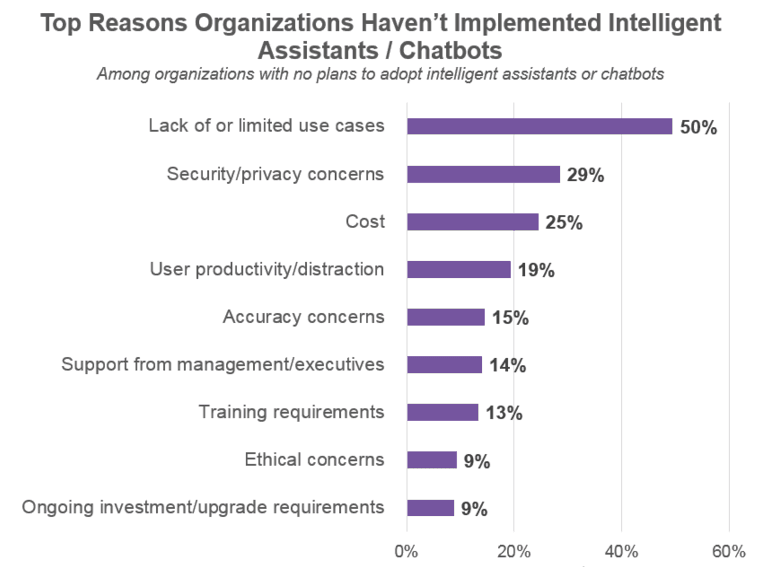
The reasons outlined in the above infographic are primarily due to businesspeople's lack of experience and, therefore, are groundless. However, chatbots have several real drawbacks, namely:
- A chatbot sometimes annoys the user. If its dialogues could be better thought out, the chatbot may scare away people rather than attract them.
- Chatbots can't always recognize the tone of a user's message. Imagine a user writes: "The service is terrible!". And the chatbot responds, "I was glad to help!" because it does not grasp the message's meaning. That's ridiculous, right?
- The chatbot does not know how to complete non-standard queries. Of course, technological advancement will likely remedy the problem sooner or later, but more quickly than desired.
Consider these disadvantages if you decide to build your chatbot. They can be easily avoided with an intelligent approach to the issue.
Key Industries Using Chatbots
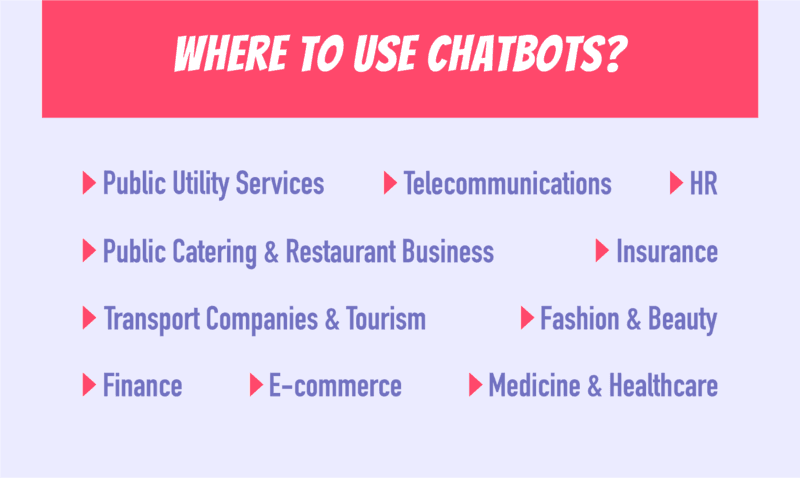
- Insurance. Chatbots could make filing an insurance claim or accepting a user request for service easier. These tasks are entirely within the power of the programmed algorithm;
- Fashion and beauty. We're talking about beauty salons, fashion stores, and other establishments dealing with this industry. Chatbots can advise consumers on the following issues: assistance in choosing clothes, an overview of the latest fashion trends, useful beauty tips, buying a product, or ordering a service.
- Telecommunications. Also, the benefits of chatbots for businesses would help you improve the efficiency of your project if it's related to the telecommunications industry. Assign chatbots to provide initial technical support to users, assist them with funding their accounts, inform them of price changes, etc.
- Public utility services. Customers dislike utilities and the companies providing them. And no wonder there are a lot of problems associated with these services! Fortunately, chatbots can bring back some people's sympathies by helping solve their problems. Consider sending notifications in case of an emergency or accident. Or providing the opportunity to check debts online?
- Medicine and healthcare. A chatbot would greatly simplify the work of medical and healthcare professionals, too. It can offer the patient an initial medical consultation, make an appointment, help find drug annotations, etc.
- Public catering and restaurant business. If you implement chatbots in your restaurant business, you'll be able to automate many processes of interaction with customers, including booking tables, ordering delivery, paying online, and the like.
- Finance. The financial services industry also needs the help of chatbots. How can they be used in such a case? Here are some pertinent ideas: assistance with money transfers, currency exchange, bank card activation, or blocking.
- E-commerce. An e-commerce chatbot helps the user complete a purchase, arrange delivery, or make a payment.
- Transport companies and tourism. Let's say a user is planning a trip abroad and needs help. Chatbots can provide it, at least at the initial stage. The chatbot would tell the user how to book a hotel room, exchange a plane ticket, plan a route, etc.
- HR. You'll also find chatbots highly useful as a recruiter: let them select suitable resumes, conduct a preliminary interview with candidates, and perform other elementary tasks.
Best Ways to Use Chatbots in Business
What tasks can and should be solved using chatbots?
- Technical support. Any site could fail, and then the user must have the opportunity to resort to the chatbot. Of course, even the most brilliant AI-based bot cannot solve complex technical issues but can send links to the necessary instructions. Sometimes, that's all it takes to tackle the problem.
- Consultation. The second example of using chatbots is more accessible to implement. Technical problems might be complex, but organizational issues fall under the competence of a chatbot. And if you have questions that consumers ask the most, train your bot to answer them. Usually, it's about the delivery terms of goods, payment options, and so on.
- Finding the content the user needs. Users are lazy and don't want to figure out the site menu independently. They prefer to ask a question in chat and get an answer. "Where is the catalog of discount products?" - the consumer asks, and the chatbot provides him with a link to a suitable website section.
- Lead generation. Also, you can use chatbots to collect customers' data. In addition to communicating with clients, the chatbot will collect and analyze information about each of them. Subsequently, the gathered data might help you improve service quality, generating many new leads.
- Assistance in completing the targeted action. If your resource is related to the sale of goods, your chatbot should advise buyers, help them choose the right product, notify them of the order status, and the like.
- Getting feedback. To meet customer expectations, it's essential to get feedback from users. Let chatbots ask them how satisfied they are with the service provided.
How to use chatbots in business without annoying customers?
- Don't disguise the chatbot as a human. Sooner or later, your trick will likely be revealed, and the client might be disappointed. But if you decide to resort to this course of action, think carefully over all dialogues and automated responses (if not, you risk losing customer loyalty).
- Always provide an option to switch to the operator. And if there is no operator, leave a particular form with a request for user contacts. Promise that he'll receive a response as soon as possible.
- Don't make up dialogues from imagination. The best way to build your chatbot and achieve good results is to create a set of Q&A based on real-life dialogues between a manager and a client. This way, you'll find out what issues potential customers care about and what answers they want to get. The more natural the dialogue between the user and the chatbot looks, the better.
- Assign only routine, simple tasks to chatbots. Don't expect miracles from the program; people must solve difficult questions.
- Analyze the results. Don't let things slide. Analyze your strategy. Have your sales improved after the chatbot implementation? What do customers say about your service? Maybe something should be improved or changed?
How to Implement Chatbots in Your Business
- Setting goals. It always starts with understanding your own needs and tasks.
- Analysis of the target audience. The second stage is critical because you must understand what language (literally and figuratively) to use to communicate with your consumer.
- Determining the actions the chatbot should automate. If you have read our article carefully, you've realized the advantages of implementing chatbots and how they might help you improve your business. Now, you have to decide on your virtual assistant's functions. Will it help clients understand the site menu? Or should it take care of the sales process?
- Creation of a scheme of interaction for a chatbot with a consumer. Mostly, it's about writing possible dialogues between a user and your robot.
- Choice of a communication channel. What platform are you going to use the chatbot on? Website, app, both?
- Setting KPIs. These indicators are needed to track the effectiveness of your strategy.
- Development and testing.
The last stage is the most complex and essential, and we'll discuss it separately.
- A ready-made solution. The first choice is simpler and more affordable, but the result isn't always perfect. Here are some suitable solutions and visual bot builders:
Flow XO: The service is aimed at creating advanced and complex chatbots.
Morph.ai: After a couple of clicks, the chatbot is ready to go! However, keep in mind that it is paid.
Botsify: This solution is free and easy to use. But, alas, the chatbot will be somewhat limited in functionality.
Gupshup: This is another beautiful solution with natural language processing capabilities, which opens up a lot of excellent prospects.
Chatfuel: the fantastic chatbot-building platform with intuitive functionality that users can integrate with Facebook Messenger. The company has several tariff plans, so you'll easily choose the package to suit your budget.
-
Full-fledged chatbot development. The second option is expensive and time-consuming; it consists of several stages, including design, development of the API, and chatbot development, testing, and launching.
Inspirational Examples of Chatbots in Business
-
Renowned clothing brand H&M has created a self-learning chatbot that asks users about their preferences and offers outfit options. The collected data forms the basis of the customer profile and helps provide a better service.

-
Telecommunications company Vodafone uses an AI chatbot named Julia. It can perform simple operations and thus save employees time. Moreover, sometimes Julia advises clients on rather complex tasks such as technical support.
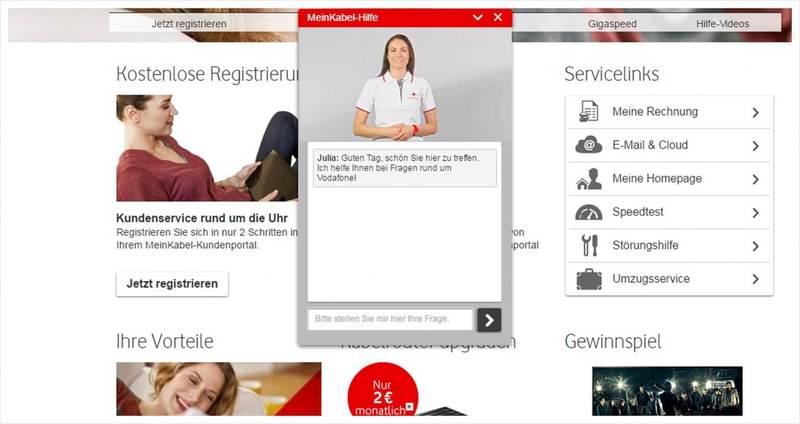
-
Bank of America also has an artificial intelligence chatbot named Erica. Erica sends notifications to users, shares money-saving tips, provides balance information, helps pay bills, and the like.
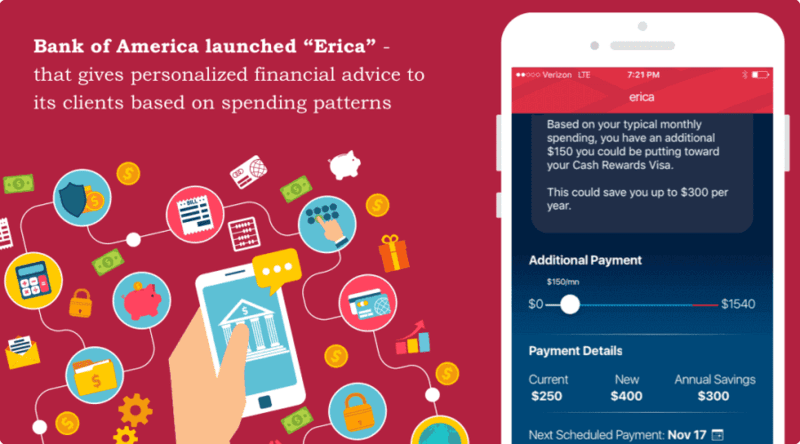
-
IKEA, too, decided to use the chatbot benefits for business purposes. Its chatbot ORC. It collects client information and requests that they disclose their contacts. The bot asks simple questions and complements them with cool emojis.
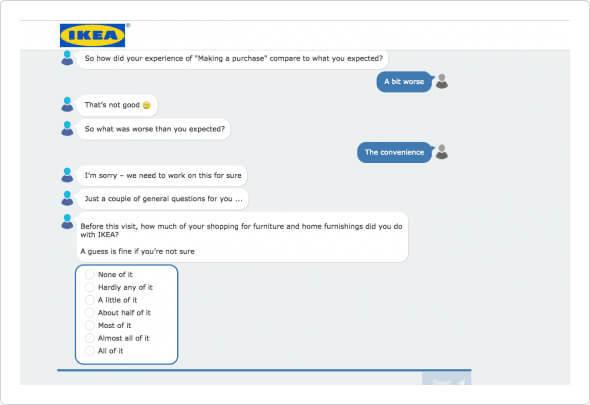
-
Car manufacturer Škoda has created a learning chatbot, Lucy. Customers discuss their needs with Lucy, tell it what kind of car they need, and receive advice from the chatbot on the most suitable Škoda model.
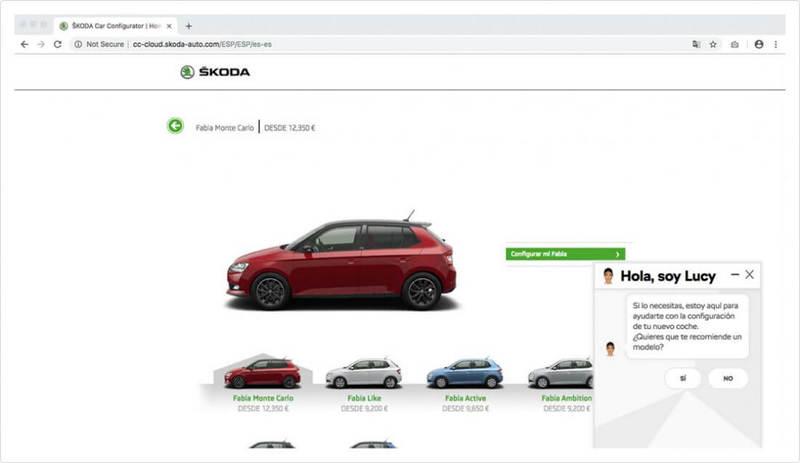
-
Dom Pizza Bot also helps the company's employees by taking orders from customers of the Domino's Pizza chain.


